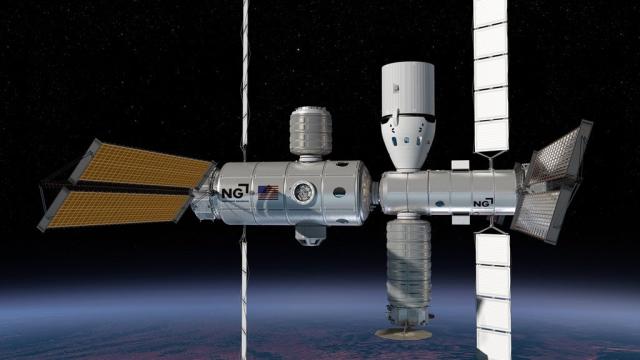NASA’s plans to retire the International Space Station and replace it with commercial projects are not kaput, they’re just changing. Wrinkles are now appearing in Blue Origin’s plans for Orbital Reef, while Northrop Grumman’s unnamed space station project might not even happen.
Ars Technica reports that Northrop Grumman may be ending its contract with NASA to develop a private space station to help fill the void left behind by the soon-to-be-retired ISS. The outlet cites anonymous sources at the International Astronautical Congress meeting, which is currently ongoing in Azerbaijan, who claim that the company will be completely severing its contract under the Space Act Agreement. Instead, Northrop Grumman will be reportedly joining Voyager Space and Airbus to develop a commercial orbiting lab.
In 2021, NASA awarded contracts to Northrop Grumman, Blue Origin, and Nanoracks to develop successors to the International Space Station, with Northrop Grumman’s contract valued at $US125.6 million.
Meanwhile, Reuters reports that fractures are continuing to appear between Blue Origin and Sierra Space in their collaboration to design an ISS replacement. The outlet says that Blue Origin is breaking up the team assigned to work on Orbital Reef—the company’s space-bound ”mixed use business park” which is being developed in collaboration with Sierra Space.
Blue Origin and NASA confirmed to Gizmodo on Friday via email that Orbital Reef is still full steam ahead, with Sierra Space serving as a sub-contractor. Sierra Space is expected to provide its Large Integrated Flexible Environment (LIFE) habitat for Orbital Reef. The habitats consist of a three-story platform designed for both low Earth orbit and long-duration missions that can house habitation and science efforts.
Announced in 2021, the planned space station passed a System Definition Review in August 2022, with NASA approving Blue Origin’s plans for the project, allowing the company to move into the design phase. Some staff originally assigned to the space station have reportedly been redirected to work on the Blue Moon lunar lander, according to Reuters. The lander is being developed after Blue Origin won a $US3.4 billion contract to build and test a human landing system in collaboration with Lockheed Martin, Boeing, Draper, Astrobotic, and Honeybee Robotics. The fully reusable Blue Moon lander will hold a crew of four and is expected to be a part of the Artemis 5 mission, scheduled for launch in 2029. The outlet reports that Brent Sherwood, who serves as the company’s head of Advanced Development Programs, is eying an exit by the end of the year
Blue Origin, Northrop Grumman, and NASA did not immediately return Gizmodo’s request for comment.
Meanwhile, Sierra Space announced a massive $US290 million in Series B funding last week to develop its own commercial space station. At the same time, the company is looking to get its Dream Chaser spaceplane off the ground. Dream Chaser is designed to fly in low Earth orbit after hitching a ride on a rocket, like ULA’s Vulcan Centaur, while handling its own atmospheric re-entry and runway landings. The plane can host three to seven crew members and up to 12,000 pounds (5,443 kilograms) of cargo, transporting it all to pivotal stops in LEO, including the International Space Station (or future commercial space stations, for that matter). The company revealed earlier this summer that it had conducted its first power-up of Dream Chaser, during which engineers simulated the power inputs that the spaceplane would generate with its solar array.
NASA announced in 2022 that the storied era of the International Space Station is set to conclude, with plans to decommission the ISS by 2030. After the crew departs, NASA will initiate maneuvers to guide the ISS to its final resting place near Point Nemo in the Pacific Ocean, the location most remote from any landmass. In September, NASA put out a request for proposals from U.S.-based private space companies to design a spacecraft to help with that deorbiting plan.
As the timeline tightens, the remaining space station construction contracts with private firms become increasingly crucial. Advisors to NASA previously raised concerns during last summer’s Aerospace Safety Advisory Panel, warning that private replacements for the ISS will not be ready before it is scheduled to be decommissioned within the next decade. That NASA’s private partners aren’t necessarily on the same page is hardly encouraging.
